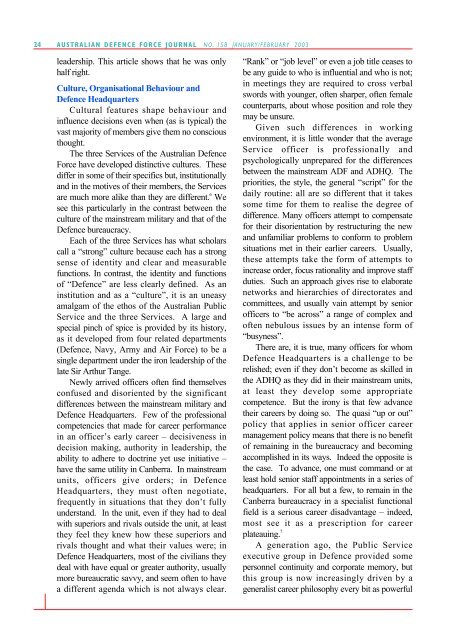ISSUE 158 : Jan/Feb - 2003 - Australian Defence Force Journal
ISSUE 158 : Jan/Feb - 2003 - Australian Defence Force Journal
ISSUE 158 : Jan/Feb - 2003 - Australian Defence Force Journal
Create successful ePaper yourself
Turn your PDF publications into a flip-book with our unique Google optimized e-Paper software.
24<br />
AUSTRALIAN DEFENCE FORCE JOURNAL NO. <strong>158</strong> JANUARY/FEBRUARY <strong>2003</strong><br />
leadership. This article shows that he was only<br />
half right.<br />
Culture, Organisational Behaviour and<br />
<strong>Defence</strong> Headquarters<br />
Cultural features shape behaviour and<br />
influence decisions even when (as is typical) the<br />
vast majority of members give them no conscious<br />
thought.<br />
The three Services of the <strong>Australian</strong> <strong>Defence</strong><br />
<strong>Force</strong> have developed distinctive cultures. These<br />
differ in some of their specifics but, institutionally<br />
and in the motives of their members, the Services<br />
are much more alike than they are different. 6 We<br />
see this particularly in the contrast between the<br />
culture of the mainstream military and that of the<br />
<strong>Defence</strong> bureaucracy.<br />
Each of the three Services has what scholars<br />
call a “strong” culture because each has a strong<br />
sense of identity and clear and measurable<br />
functions. In contrast, the identity and functions<br />
of “<strong>Defence</strong>” are less clearly defined. As an<br />
institution and as a “culture”, it is an uneasy<br />
amalgam of the ethos of the <strong>Australian</strong> Public<br />
Service and the three Services. A large and<br />
special pinch of spice is provided by its history,<br />
as it developed from four related departments<br />
(<strong>Defence</strong>, Navy, Army and Air <strong>Force</strong>) to be a<br />
single department under the iron leadership of the<br />
late Sir Arthur Tange.<br />
Newly arrived officers often find themselves<br />
confused and disoriented by the significant<br />
differences between the mainstream military and<br />
<strong>Defence</strong> Headquarters. Few of the professional<br />
competencies that made for career performance<br />
in an officer’s early career – decisiveness in<br />
decision making, authority in leadership, the<br />
ability to adhere to doctrine yet use initiative –<br />
have the same utility in Canberra. In mainstream<br />
units, officers give orders; in <strong>Defence</strong><br />
Headquarters, they must often negotiate,<br />
frequently in situations that they don’t fully<br />
understand. In the unit, even if they had to deal<br />
with superiors and rivals outside the unit, at least<br />
they feel they knew how these superiors and<br />
rivals thought and what their values were; in<br />
<strong>Defence</strong> Headquarters, most of the civilians they<br />
deal with have equal or greater authority, usually<br />
more bureaucratic savvy, and seem often to have<br />
a different agenda which is not always clear.<br />
“Rank” or “job level” or even a job title ceases to<br />
be any guide to who is influential and who is not;<br />
in meetings they are required to cross verbal<br />
swords with younger, often sharper, often female<br />
counterparts, about whose position and role they<br />
may be unsure.<br />
Given such differences in working<br />
environment, it is little wonder that the average<br />
Service officer is professionally and<br />
psychologically unprepared for the differences<br />
between the mainstream ADF and ADHQ. The<br />
priorities, the style, the general “script” for the<br />
daily routine: all are so different that it takes<br />
some time for them to realise the degree of<br />
difference. Many officers attempt to compensate<br />
for their disorientation by restructuring the new<br />
and unfamiliar problems to conform to problem<br />
situations met in their earlier careers. Usually,<br />
these attempts take the form of attempts to<br />
increase order, focus rationality and improve staff<br />
duties. Such an approach gives rise to elaborate<br />
networks and hierarchies of directorates and<br />
committees, and usually vain attempt by senior<br />
officers to “be across” a range of complex and<br />
often nebulous issues by an intense form of<br />
“busyness”.<br />
There are, it is true, many officers for whom<br />
<strong>Defence</strong> Headquarters is a challenge to be<br />
relished; even if they don’t become as skilled in<br />
the ADHQ as they did in their mainstream units,<br />
at least they develop some appropriate<br />
competence. But the irony is that few advance<br />
their careers by doing so. The quasi “up or out”<br />
policy that applies in senior officer career<br />
management policy means that there is no benefit<br />
of remaining in the bureaucracy and becoming<br />
accomplished in its ways. Indeed the opposite is<br />
the case. To advance, one must command or at<br />
least hold senior staff appointments in a series of<br />
headquarters. For all but a few, to remain in the<br />
Canberra bureaucracy in a specialist functional<br />
field is a serious career disadvantage – indeed,<br />
most see it as a prescription for career<br />
plateauing. 7<br />
A generation ago, the Public Service<br />
executive group in <strong>Defence</strong> provided some<br />
personnel continuity and corporate memory, but<br />
this group is now increasingly driven by a<br />
generalist career philosophy every bit as powerful

















